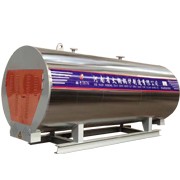Gas hot water boiler maintenance
2021.03.05
Pressure maintenance
It is applicable to the production of standby boilers or boilers that are shut down for short-term maintenance for no more than one week.
(1) After shutdown, drain all the boiler water, clean up the scale and slag in the furnace, and add qualified softened water again.
(2) Heat the boiler water regularly with small fire or steam from adjacent boilers, so that the boiler water temperature in the boiler shall be kept at the ambient temperature of + 10 ℃ in summer, and the boiler water shall not be frozen in winter. Close all vent valves, blowdown valves and drain valves to prevent water leakage.
(3) Feed water to the boiler regularly, keep the pressure in the boiler at 0.05 MPa ~ 0.1MPa, and prevent air from entering the drum.
Wet maintenance
Wet maintenance is generally applicable to the maintenance of boilers whose shutdown time is less than one month.
(1) After the boiler is shut down, the boiler water shall be drained according to the specified time, and the scale, water slag and ash shall be removed.
(2) Close all manholes, handholes, valves, etc., completely isolated from the running boiler.
(3) Prepare alkaline protection solution with qualified softened water. Add 8 kg ~ 10 kg sodium hydroxide, 20 kg sodium carbonate or 20 kg sodium phosphate to each ton of boiler water.
(4) Use a special pump to inject the prepared alkaline maintenance solution into the boiler.
(5) When the protection solution is fully injected, open the feed water valve to fill the boiler with qualified softened water until the water overflows from the air valve, then close the air valve and feed water valve, and start the special pump circulation to make the solution mix evenly.
(6) During the whole maintenance period, the micro fire oven should be used regularly to keep the outside of the heating surface dry, the pump circulation should be started regularly to make the solution concentration consistent, and the solution should be taken for test and replenished regularly to make the pH value of the solution between 10 and 12 to ensure the alkalinity of the boiler water.
(7) In winter, the corresponding antifreeze measures should be taken.
Dry maintenance
Dry maintenance is suitable for heating and hot water boilers that have been shut down for a long time, usually more than one month, especially in summer.
(1) After the boiler is shut down, drain the boiler water to remove the scale, water slag and ash on the heating surface.
(2) Close the valves on the water supply pipe, water supply pipe and blowdown pipe of the boiler, or block them tightly with clapboard to completely isolate them from other operating boilers.
(3) Open the manhole and handhole to dry the boiler naturally. If the boiler is wet, dry the boiler body, furnace wall and flue with micro fire.
(4) Select appropriate amount of desiccant. The commonly used desiccants are anhydrous calcium chloride (CaCl2) and quicklime (Cao 2). CaCl2 is placed according to the volume of 2kg per cubic meter of water, and particles of about 15mm are required; quicklime is placed according to the volume of 3kg per cubic meter of water, and blocks of 10mm ~ 30mm are required.
(5) After drying the boiler, put the tray with desiccant into the furnace and drum to absorb moisture. The desiccant shall not directly contact with the heating surface of the boiler.
(6) If the desiccant is put into the boiler for one month, it should be checked once a week to see if there is corrosion on the heating surface. Replace the invalid desiccant in time. After one month, it should be checked every half a month.
 Gas & Oil Fired Boiler
Gas & Oil Fired Boiler
 Biomass Fired Boiler
Biomass Fired Boiler
 Coal Fired Boiler
Coal Fired Boiler







